英语时态结构,标志词总结
英语12种时态的标志词
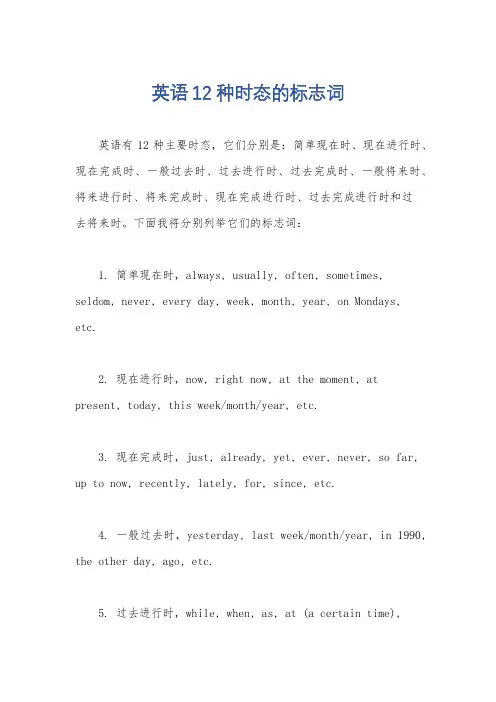
英语12种时态的标志词英语有12种主要时态,它们分别是:简单现在时、现在进行时、现在完成时、一般过去时、过去进行时、过去完成时、一般将来时、将来进行时、将来完成时、现在完成进行时、过去完成进行时和过去将来时。
下面我将分别列举它们的标志词:1. 简单现在时,always, usually, often, sometimes, seldom, never, every day, week, month, year, on Mondays, etc.2. 现在进行时,now, right now, at the moment, at present, today, this week/month/year, etc.3. 现在完成时,just, already, yet, ever, never, so far, up to now, recently, lately, for, since, etc.4. 一般过去时,yesterday, last week/month/year, in 1990, the other day, ago, etc.5. 过去进行时,while, when, as, at (a certain time),etc.6. 过去完成时,by the time, already, just, never, ever, yet, so far, since, for, how long, etc.7. 一般将来时,tomorrow, next week/month/year, in 2023, soon, etc.8. 将来进行时,this time tomorrow, this time nextweek/month/year, in a week/month/year's time, etc.9. 将来完成时,by the time, in a week/month/year, etc.10. 现在完成进行时,for, since, how long, all day, all morning, all afternoon, etc.11. 过去完成进行时,by, before, when, until, etc.12. 过去将来时,would, was/were going to, would be, etc.以上是这12种时态的标志词,它们有助于我们理解句子所表达的时间和动作关系。
16种英语时态表格归纳
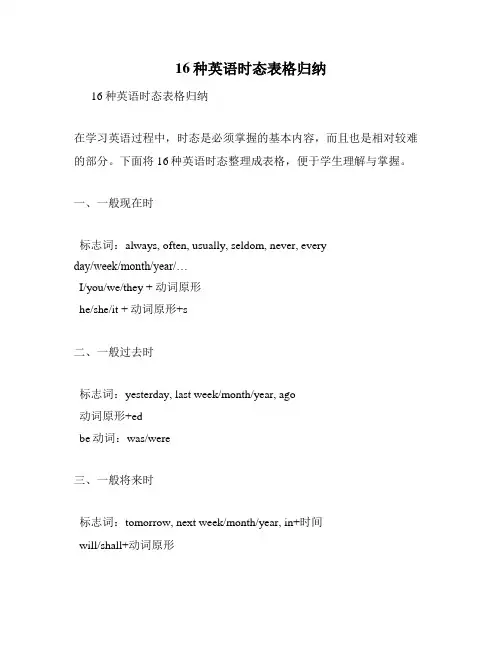
16种英语时态表格归纳16种英语时态表格归纳在学习英语过程中,时态是必须掌握的基本内容,而且也是相对较难的部分。
下面将16种英语时态整理成表格,便于学生理解与掌握。
一、一般现在时标志词:always, often, usually, seldom, never, everyday/week/month/year/…I/you/we/they + 动词原形he/she/it + 动词原形+s二、一般过去时标志词:yesterday, last week/month/year, ago动词原形+edbe动词:was/were三、一般将来时标志词:tomorrow, next week/month/year, in+时间will/shall+动词原形四、现在进行时标志词:now, at the moment, right now, currently am/is/are+现在分词五、过去进行时标志词:at+时间,when, whilewas/were+现在分词六、将来进行时标志词:at+时间will/shall+be+现在分词七、现在完成时标志词:ever, never, already, yet, justhave/has+过去分词八、过去完成时标志词:before, by the timehad+过去分词九、将来完成时标志词:by+时间will/shall+have+过去分词十、一般过去时被动语态标志词:被动语态was/were+过去分词十一、现在完成时被动语态标志词:被动语态have/has+been+过去分词十二、过去完成时被动语态标志词:被动语态had+been+过去分词十三、一般将来时被动语态标志词:被动语态will/shall+be+动词过去分词十四、现在进行时被动语态标志词:被动语态am/is/are+being+过去分词十五、过去进行时被动语态标志词:被动语态was/were+being+过去分词十六、将来进行时被动语态标志词:被动语态will/shall+be+being+过去分词以上是英语16种时态的表格汇总,当然还有很多语法细节需要注意,而且有些时态在实际使用过程中还会存在一些变化。
最新初中英语各个时态的句子结构及标志词
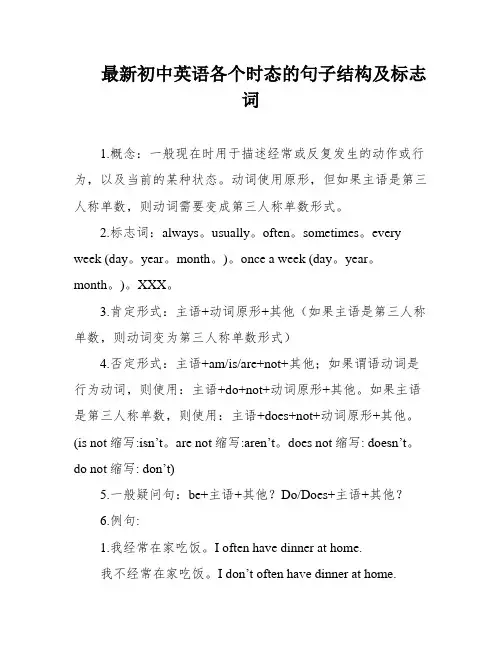
最新初中英语各个时态的句子结构及标志词1.概念:一般现在时用于描述经常或反复发生的动作或行为,以及当前的某种状态。
动词使用原形,但如果主语是第三人称单数,则动词需要变成第三人称单数形式。
2.标志词:always。
usually。
often。
sometimes。
every week (day。
year。
month。
)。
once a week (day。
year。
month。
)。
XXX。
3.肯定形式:主语+动词原形+其他(如果主语是第三人称单数,则动词变为第三人称单数形式)4.否定形式:主语+am/is/are+not+其他;如果谓语动词是行为动词,则使用:主语+do+not+动词原形+其他。
如果主语是第三人称单数,则使用:主语+does+not+动词原形+其他。
(is not缩写:isn’t。
are not缩写:aren’t。
does not缩写: doesn’t。
do not缩写: don’t)5.一般疑问句:be+主语+其他?Do/Does+主语+其他?6.例句:1.我经常在家吃饭。
I often have dinner at home.我不经常在家吃饭。
I d on’t often have dinner at home.你经常在家吃饭吗?Do you often have dinner at home?2.XXX喜欢唱歌。
XXX singing.XXX不喜欢唱歌。
XXX’t like singing.XXX喜欢唱歌吗?Does Tom like singing?3.他总是准备着去帮助别人。
He is always ready to help others.他不总是准备着去帮助别人。
He is not always ready to help others.他总是准备着去帮助别人吗?Is he always ready to help others?二、一般过去时1.概念:一般过去时用于描述过去某个时间发生的动作或状态,以及过去的惯性或经常性的动作或行为。
八种时态常用的标志词
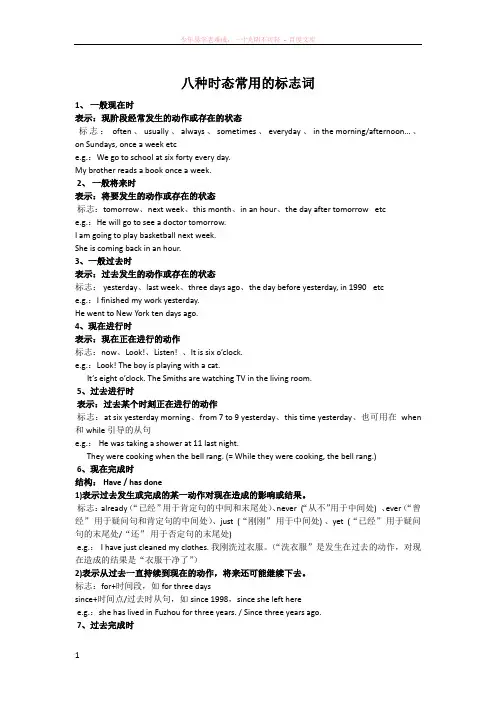
八种时态常用的标志词1、一般现在时表示:现阶段经常发生的动作或存在的状态标志:often、usually、always、sometimes、everyday、in the morning/afternoon…、on Sundays,once a week etce.g.:We go to school at six forty every day.My brother reads a book once a week.2、一般将来时表示:将要发生的动作或存在的状态标志:tomorrow、next week、this month、in an hour、the day after tomorrow etce.g.:He will go to see a doctor tomorrow.I am going to play basketball next week.She is coming back in an hour.3、一般过去时表示:过去发生的动作或存在的状态标志:yesterday、last week、three days ago、the day before yesterday,in1990etce.g.:I finished my work yesterday.He went to New York ten days ago.4、现在进行时表示:现在正在进行的动作标志:now、Look!、Listen! 、It is six o’clock.e.g.:Look!The boy is playing with a cat.It’s eight o’clock.The Smiths are watching TV in the living room.5、过去进行时表示:过去某个时刻正在进行的动作标志:at six yesterday morning、from7to9yesterday、this time yesterday、也可用在when 和while引导的从句e.g.:He was taking a shower at11last night.They were cooking when the bell rang. (=While they were cooking,the bell rang.)6、现在完成时结构:Have/has done1)表示过去发生或完成的某一动作对现在造成的影响或结果。
十六种时态结构例句标志词

for, since, so far,in/over/duringthepast/ lastfew years, lately, recently, just, up to now, up till now,until now,already, yet, ever, never, twice, three times, before
would have been done
would have been being done
Hesaidhe would come.
Hesaidhe would be sleeping at this time tomorrow.
The teachersaidwe would have learnt 20 unitsby the end of this term.
by+过去时间,by then,by the end of +过去时间,by the time you did sth.
将来
will do
will be doing
will have done
will have been doing
will be done
will be being done
will have been done
all the time, all this morning, forthree years, sincehe was five, in the past few years
过去
did
was/wereHale Waihona Puke doinghad done
八大时态的标志词
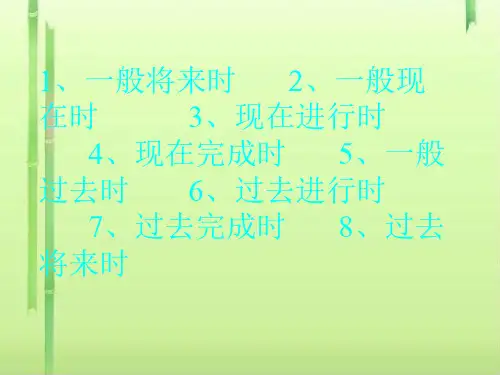
(4)soon = right away = at once
一般过去时
1)yesterday, the day before yesterday, yesterday morning
1)yesterday, the day before yesterday, yesterday morning (evening, afternoon)
(3)2 hours ago, a week ago, 3 years ago 1、一般将来时
2、一般现在时
before3、现在进行时
4、现在完成时
at that moment.
(1)already, yet, ever, never, just, before
What is he doing? He is watching Tv. 1、一般将来时
2、一般现在时
点时间3、现在进行时
4、现在完成时
5、一般过去时
6、过去进行时
7、过去完成时
8、过去将来时பைடு நூலகம்
2、一般现在时
3、现在进行时
4、现在完成时
5、一般过去时
6、过去进行时
7、过去完成时
8、过去将来时
过去完成时
1.by,by the time (of),by the end of,+过去时间
2when.before.after…….+过去时 间
现在进行时
1.now.Look.Listen.
2.What is he doing? He is watching Tv.
英语各个时态的句子结构及标志词
英语各个时态的句子结构及标志词一、一般现在时1.概念:经常、反复发生的动作或行为及现在的某种状况。
一般现在时用动词原形表示。
如主语为第三人称单数,动词上要改为第三人称单数形式。
2.标志词:Always, usually, often, sometimes, every week (day, year, month…), once a week(day, year, month…), on Sundays3.肯定形式:动词+动词原形+其他4.否定形式:主语+am/is/are +not+其他;此时态的谓语动词若为行为动词,则为:主语+do+not+动词原形+其他,如主语为第三人称单数,则用:主语+does+not+动词原形+其他。
(is not缩写:isn’t, are not缩写:aren’t, does not缩写: doesn’t , do not 缩写: don’t)5.一般疑问句:be+主语+其他?Do/Does+主语+其他?6. 例句: 1. I often have dinner at home.. 我经常在家吃饭。
I don’tofter have dinner at home.Do you often have dinner at home?2.Tom likes singing. 汤姆喜欢唱歌。
Tom doesn’t like singing.Does Ton like singing?3.He is always ready to help others. 他总是准备着去帮助别人。
He is not always ready to help others.Is he always ready to help otheres?二、一般过去时1.概念:过去某个时间里发生的动作或状态;过去习惯性、经常性的动作、行为。
用动词的过去时表示。
时间词+ago,(two 2.时间状语:, yesterday, the day before yesterday, last week, last(year, night, month…),years ago), in/on+表示过去的时间词(in 1989), just now(刚才), at the age of 5, one day, long longago(很久以前), once upon a time(曾经)3.基本结构:be动词(was, were);行为动词的过去式(助动词:did)4.肯定形式:主语+动词的过去时+其他5.否定形式:主语+was/were +not+其他; 主语+did not+动词原形+其他(did not 缩写:didn’t)6.一般疑问句:was或were放于句首;用助动词do的过去式did 提问,同时还原行为动词。
小学英语四种时态结构及常用标志词
小学英语四种时态结构及常用标志词/时间状语名称基本结构标志词/时间状语肯定句否定句一般疑问句一般现在①主语+ am/is/are动词+ 其他;主语+ am/is/are + not + 其他; Am/is/are+主语+ 其他often, usually,always,sometimes,seldom,everyday/week/month…once a week,...on Sundays等。
②主语+ 动词(原形)+ 其他主语(三单)+动词(三单)+ 其他主语+don't+动词(原形)+其他,主语(三单)+doesn't+动词(原形)+ 其他;Do+主语+ 动词(原形)+ 其他Does+主语+ 动词(原形)+ 其他一般过去①主语+ was/were + 其他;主语+ was/were + not + 其他; Was/were +主语+ 其他yesterday,last week…two months ago, in 1990,just now②主语+动词(过去式)+ 其他主语+didn't+动词(原形)+其他,Did+ 主语+动词(原形)+ 其他现在进行主语+ am/is/are + doing + 其他.主语+ am/is/are + not + doing + 其他. Am/is/are+主语 + doing + 其他now, Look,...Listen, ...at the moment.一般将来①主语+ am/is/are/going to +do + 其他;①主语+ am/ia/are + not + going to + do +其他;Am/is/are/+主语+going to + do + 其他;tomorrow...,nexttime...,in +一段时间soon = right away = atoncelater (on) in thefuture②主语+ will/shall + do + 其他.②主语+ will/shall + not + do + 其他 Will/shall +主语+ do + 其他.。
英语动词时态的结构及标志词Microsoft Word 文档 (2)
英语动词时态的结构及标志词1.一般现在时态:结构:①主+be(am/is/are)+其他②主+实义动词(动词原形/单三式)+其他标志词:often, always, usually, sometimes , every week (day/year/month…), how often,once a week, twice a year,three times a day,on Sundays, on weekdays; if, when ,before, after, not…until, as soon as…(的从句里)2.现在进行时态:结构:主+be(am/is/are)+动词现在分词v-ing +其他标志词:now, at the moment, at present ,these days ,Look! Listen! Be quiet!/ Don’t make any noise!/ Stop making noise!Xiao Qiang is sleeping3.一般过去时态:结构:①主+be(was/ were)+其他②主+动词过去式(did)+其他标志词:yesterday, the day before yesterday, yesterday morning (evening/ afternoon);last time, last Friday, last term, last month;一段时间+ago:2 hours ago, a week ago, 3 years ago;just now = a moment ago ;in 1989;at the age of 5, one day, long long ago, once upon a time,in the past,once,during the war,the other day…4.过去进行时态结构:主+be(was/ were)+动词现在分词v-ing+其他标志词:at that moment, at this time of yesterday, at eight last night,at 8:00am yesterday,at this time last night ,at that time;以when/while引导的谓语动词是一般过去时的时间状语5. 一般将来时态:结构:①主+will/shall+动词原形…②主+be going to +动词原形…③主+be+ v-ing +…标志词:tomorrow, the day after tomorrow,tomorrow morning (evening, afternoon);next time, next Friday, next term, next month;in+ 一段时间, in + 一段时间 ' s + time;in the future, soon,from now on;by the end of + 将来时间; if, when ,before, after, not…until, as soon as…(的主句里)6. 现在完成时态:结构:主+have/has+动词过去分词(done)+其他标志词:just, already, yet, ever, never, before; twice, once ,three times, at the moment, at present;for+时间段;since+过去的时间点/ 时间状语从句(动词用过去时态),since + 一段时间 + ago;lately,recently,up to now, till now, so far, these days,in/during the past/last few years(months/weeks/days)一选择题:( )1. Mike usually ____ up at six in the morning.A. getB. getsC. gotD. will get( )2. The sun _____ us light and heat.A. giveB. givesC. will giveD. often give( )3. Tom looked sad and cried , “ I ____ terrible !”A. am feeling B feels C. will feel D. have felt( )4. At that time , things _____ hard for the working people.A. isB. areC. wasD. were( )5. We ____ a meeting these days.A. haveB. hadC. are havingD. were having( )6. I ____ the boy in the classroom just now .A. seeB. sawC. have seenD. had seen( )7. Mr. Black was surprised, “ I ______ I lost my wallet. “A. knowB. don’t knowC. knewD. didn’t know( )8. The guard said, “ I am sorry. I ____ .”A. don’t know it is youB. didn’t know it is youC. don’t know it was youD. didn’t know it was you( )9. He is going to be a doctor when he _____.A. grow upB. grows upC. will grow upD. is going to grow up ( )10. Grandma said she would tell me a story when she _____.A. has timeB. had timeC. would have timeD. would has time ( )11. I’ll tell him all about it as soon as he ____.A. come backB. comes backC. will come backD. is going come back ( )12.____ we set off right away ?A. WillB. ShallC. AreD. Do( )13. It seems it ______.A. will rainB. shall rainC. rainsD. is going to rain( )14. My little sister ____ six next month.A. will beB. shall beC. can beD. is going to( )15. It’s nothing serious. Your son ____ all right by supper time.A. will beB. shall beC. isD. is going to be( )16. I’ll talk to him when he ______.A. comeB. will comeC. comesD. came( )17. They _____ supper when we _____ into the room.A. are having…wentB. were having…goC. were having…wentD. are having…go( )18. We’ll go climbing if it _____ tomorrow.A. won’t rainB. did rainC. isn’t rainD. doesn’t rain( )19. I don’t know if it _____ tomorrow.A. will rainB. rainsC. rainedD. is rain( )20. How long _____ your uncle ____ in the army?A. has…joinedB. has…beenC. does…joinD. had…joined( )21. Peter _____ the work in a week.A. have finishedB. finishesC. is finishingD. will finish二用动词的适当形式填空:31. He can’t go to the cinema with me because he ____ (have)a meeting.32. ——I have got a headache.——No wonder. You ____(work) in front of that computer too long.33. ——Did you see a man in black pass by just now?——No,sir. I ____(read) a newspaper.34. Danny ____ (work) hard for long to realize his dream and now he is popular.35.Ben is a foreign teacher. So far, he (teach) in Shiyan for 10years.(2012,Shiyan)36.If we see someone breaking the rules, we may (polite) give them some suggestions. (2012,Shiyan)37.My sister always spends the whole weekend (hang out) the department store. (2012,Shiyan)38.At present, the price of the houses in big cities (更高)than that in small cities. (2012,Shiyan)39.Although Wu Bin was seriously hurt on the expressway, he did what he could (为了挽救乘客的生命).(2012,Shiyan)40.If you (see)him tomorrow, please ask him if he (go) to work on the farm with him.41. He doesn’ t tell me when he (come) back. I’ ll telephone you as soon as he (come) back.三选择单词,用其适当的形式填空,是短文意思正确通顺。
英语的八种主要时态的结构及口诀
英语的八种主要时态的结构及口诀-CAL-FENGHAI.-(YICAI)-Company One1英语的八种主要时态的结构一、一般现在时:概念:经常、反复发生的动作或行为及现在的某种状况。
例:He listens to the radio every evening.时间状语:always, usually, often, sometimes, every week (day, year, month…), once a week, on Sunday, etc.基本结构:①be动词;②行为动词否定形式:①am/is/are +not;②此时态的谓语动词若为行为动词,则在其前加don't,如主语为第三人称单数,则用doesn't,同时还原行为动词。
一般疑问句:①把be动词放于句首;②用助动词do提问,如主语为第三人称单数,则用does,同时,还原行为动词。
二、一般过去时:概念:过去某个时间里发生的动作或状态;过去习惯性、经常性的动作、行为。
例:I was born on April 2, 1986.时间状语:ago, yesterday, the day before yesterday, last week(year, night, month…), in 1989, just now, at the age of 5, one day, once upon a time, etc.基本结构:①be动词;②行为动词否定形式:①was/were +not;②在行为动词前加didn't,同时还原行为动词。
一般疑问句:①was或were放于句首;②用助动词do的过去式did 提问,同时还原行为动词。
三、现在进行时:概念:表示现阶段或说话时正在进行的动作及行为。
例:The woman is talking to the doctor.时间状语:now, at this time, these days, etc.基本结构:am /is/are +doing否定形式:am /is/are +not +doing.一般疑问句:把be动词放于句首。
- 1、下载文档前请自行甄别文档内容的完整性,平台不提供额外的编辑、内容补充、找答案等附加服务。
- 2、"仅部分预览"的文档,不可在线预览部分如存在完整性等问题,可反馈申请退款(可完整预览的文档不适用该条件!)。
- 3、如文档侵犯您的权益,请联系客服反馈,我们会尽快为您处理(人工客服工作时间:9:00-18:30)。
英语时态结构,标志词总结⑴、一般现在时结构:主+be(am/is/are)+其他/ 主+实义动词+其他/ 主+情态动词+动原+其他标志词:often, always, usually, sometimes , every week (day/year/month…), once a week, on Sundays, on weekdays,from time to time⑵、一般将来时结构:主+will/shall+其他/主+be going to +其他/主+be+动-ing+其他…标志词:tomorrow,in the future, next week , next Sunday,the day after tomorrow,in+ 一段时间,soon,from now on⑶、一般过去时结构:主+be(was/ were)+其他/ 主+动词过去式+其他/标志词:一段时间+ago,yesterday, in 1945,at that time,once,during the war,before,in the past , the day before yesterday, last week(year/ night/ month…), just now, at the age of 5, one day, long long ago, once upon a time,this morning,a moment ago⑷、现在完成时结构:主+have/has+动词过去分词+其他标志词:ever, never, since, already, yet, just, before, twice, once ,three times, at the moment, at present/for+时间段;since+时间点/常见的副词:lately,recently,up to now, till now,so far, these days,in the past few years(months /weeks/days)⑸、现在进行时结构:主+be(am/is/are)+动词现在分词+其他标志词:now,at the moment !at this time ,these days ,Look!Listen!⑹、过去进行时结构:主+be(was/ were)+动词现在分词+其他标志词:at that moment, at this time of yesterday, at eight last night,at 8:00am yesterday,at this time last night ,at that time⑺、过去完成时结构:主+had+动词过去分词+其他标志词:by the end of last year(term, month…),过去完成时常用在told,said,knew,heard等词后的宾语从句或间接引语中,这时从句中的动作发生在主句表示的过去的动作之前。
⑻、过去将来时结构:主+would/should+其他/主+was/were going to +其他标志词:the next day/morning/year,the following year/week/month英语部分语法顺口溜⑴、名词:记住f(e)结尾的名词复数:(把f(e)变成v在加es)妻子(wife)持刀(knife)去宰狼(wolf),小偷(thief)吓得发了慌;躲在架(shelf)后保己(self)命(life),半(half)片树叶(leaf)遮目光。
“某国人”的单复数:中日不变(Chinese、Japanese )英法变(Englishman/Britishman→Englishmen/Britishmen 、Frenchman→Frenchmen)其余s加后面(Australians、Germans、Russians、Americans、Indians、Italians、Koreans 、Canadians)巧计名词单复数同形的:中国人和日本人喜欢绵羊、鹿和鱼Chinese 、Japanese、sheep、deer、fish巧记以-o结尾加-es的词:A.“两人两菜”(hero, negro, potato, tomato)B.一句话Negroes and heroes like to eat potatoes and tomatoes.巧记不规则名词单变复:男女脚步牙鹅,老鼠加虱婆。
man-men; woman-women; foot-feet; tooth-teeth; goose-geese; mouse-mice; louse-lice.⑵、动词:Be动词的用法:我用am,你用are,is跟着他她它,凡是复数都用are感官使役动词“八字言”:一感feel,二听hear, listen to,三让have, let, make,四看see, look at, observe, watch半帮助:help(另外还有:notice ,taste ,smell)感官使役动词用法:感使动词真奇怪,to在句中像妖怪;主动句里to走开,被动句里to回来用“不定式”和“动名词”造成的意义上的差别归为五点:不定式动名词A).某一具体行动指一般的、经常的情况B).表示主语和宾语的动作可能表示任何人的动作C).主动被动D).未发生的事已发生的事E).短暂的或可能进行的事延续的或重复发生的事接“不定式”作宾语的动词:(vt+to do)三个希望两答应:hope,wish,want,agree,promise两个要求莫拒绝:demand,ask,refuse设法学会做决定:manage,learn,decide不要假装在选择:petend,choose要求跟“不定式”作宾补的动词:(vt+sb/sth +to do)(1)劝教命请叫(advise, teach, order, command, ask, tell)(2)允许又警告( allow, permit, warn)(3)使役表意向(cause, let, have, make, lead, set, leave, get, wish, want, expect)(4)知觉动词妙(feel, hear, watch, see, observe, notice)<省去to>带双宾的动词:“七给”,“一带”to不少,(vt.+sth直宾+to+sb间宾; vt+sb+sth)(give给、pass递给、lend借给、write写给、show给…看、send寄给、hand 交给)(bring带)“买”“画”“制作”for来了。
(vt.+sth直宾+for+sb间宾)(buy、draw、make)既跟动名词也跟不定式的动词:(vt+ doing /vt+to do)begin, start, continue, forget, remember, regret, intend, like, love, hate, try, mean只能接“动名词”作宾语的动词:(vt+ doing)值得、想象、莫回避,建议、坚持别放弃不禁、完成、莫推迟,喜爱、练习不介意错过、考虑、介词to,后接动词加-ing动词:mind,finish,enjoy,suggest,permit,appreciate,consider,miss,dislike,keep(on),avoid,permit,imagine,risk,escape,admit,stand(忍受),allow,forbid,excuse短语:give up,put off,look forward to,feel like,insist on,object to,prevent…from,set about,can't help,be/get used to,be worth doing,be no good doing,be no use doing,be busy doing ,pay attention to加-ing要双写的常见动词:一m(swim)两d和g(nod, rid) (dig, beg)三n(run, win, begin)四p(dip, drop, mop, stop),十t(sit, hit, fit, set, get, bet, put, regret, forget, pat)(下加线的词,构成过去式、过去分词时,也须双写尾字母)只能接不定式做宾语如:(v+to do)help,hope,ask,refuse,decide,promise,wish,pretend,expect,arrange,learn,plan,demand,dare,manage,agree,prepare,fail,determine,offer,choose,desire,elect,long,(happen,seem)⑶、数词:基变序,有规律,词尾加上th,一二三特殊记,结尾字母t/d/d,八减t,九减e,f代ve,几加几要注意,前为基数后为序⑷、其他:对划线部分提问的程序:一代(用疑问词代替划线部分),二移(把疑问词移至句首)三倒(颠倒主谓语,但对主语或其定语提问时除外)四抄(照抄其它部分)some time与some times:分开是“一段”,相连是“某时”分开s是“倍次”,相连s是“有时”巧计比较级不规则变化:“坏”“病”两“多”和两“好”一是“远”来二是“老”“litter”是少不是小⑸、a和an的用法:An hour ago, an honest man accepted an honorable task.(一小时前,一位诚实的人接受了一项光荣的任务。
)In a university, a European and a one-eyed man walk along a one-way road with a usual tool. This is a usual thing.(在一所大学里,有一个欧洲人和一个独眼龙拿着有用的工具沿着一条单行道行走,这是件平常的事。
)在26个英文字母中,a, e, i, o, f, h, l, m, n, r, s, x等12个字母的读音是以元音开头的,其余字母则是以辅音.宾语从句的主语:一随主,二随宾,三不变。
e.g.(1)She said "I will go home ."改:She said that she would go home.(一随主)(2)She said to me "You can go with me.".改She said to me that I could go with her.(二不变)(3) She said to me "He will go home."改She said to me that he would go home.(三不变)2.宾语从句中注意时态1.若主语为一般过去时,则宾语从句的时态要变为过去的某一时态。
